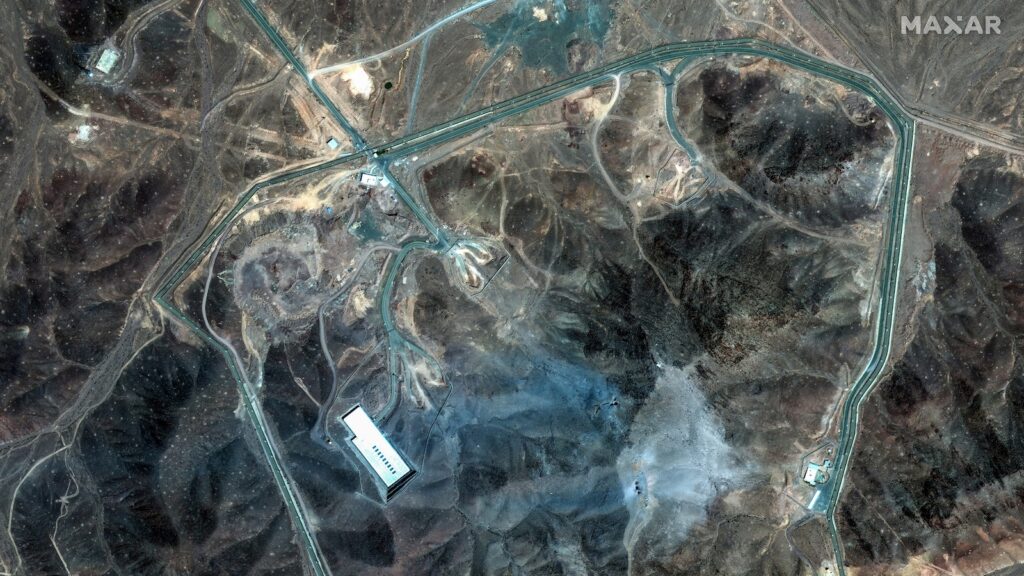
Satellite images have unveiled the extensive damage inflicted on Iran’s key nuclear sites following a series of U.S. airstrikes, raising global concerns about the escalating tensions in the region. The images, provided by Maxar Technologies, depict significant destruction at the Fordo, Isfahan, and Natanz facilities, which were targeted during the U.S. military operation dubbed “Midnight Hammer” on June 22, 2025.
President Donald Trump declared that the sites were “completely and totally obliterated,” though some officials have advised caution, noting that a comprehensive battlefield damage assessment is still pending. Joint Chiefs Chairman Gen. Dan Caine emphasized the severity of the strikes, stating, “Initial battle damage assessments indicate that all three sites sustained extremely severe damage and destruction.”
Fordo Nuclear Site: A Closer Look
The Fordo enrichment facility, located approximately 60 miles south of Tehran, is a critical component of Iran’s uranium enrichment program. The satellite images show several large craters and a layer of blue ash, suggesting significant impacts from the strikes. The entrances to the underground facility appear obstructed, possibly by dirt, though it remains unclear whether this was a result of the strikes or preemptive measures by Iranian forces.
International Atomic Energy Agency Director General Rafael Grossi commented, “It is clear that Fordow was also directly impacted, but the degree of damage inside the uranium enrichment halls can’t be determined with certainty.” Experts believe the craters may have targeted the facility’s ventilation shafts, indicating a strategic aim to disrupt operations.
“Looks like Fordo was hit with at least six Massive Ordinance Penetrators (MOPs) given the six craters,” stated Sam Lair, a research associate at the Middlebury Institute’s James Martin Center for Nonproliferation Studies.
The presence of blue/gray ash, identified as ejecta from the MOP impacts, is not a direct indication of radioactivity, according to MIT professor Jacopo Buongiorno. However, the true extent of the damage remains uncertain until further inspections can be conducted.
Destruction at Isfahan Nuclear Technology Center
The Isfahan facility, another critical node in Iran’s nuclear infrastructure, has suffered extensive damage, with over a dozen buildings reportedly destroyed. This follows earlier Israeli strikes that had already compromised parts of the site. The U.S. strikes appear to have focused on areas dedicated to uranium conversion, severely impacting the facility’s operational capabilities.
Rafael Grossi noted, “The latest attacks early this morning damaged other buildings in Esfahan. In addition, we have established that entrances to underground tunnels at the site were impacted.”
The strategic targeting of Isfahan underscores the U.S. intent to cripple Iran’s nuclear capabilities, a move that has drawn international scrutiny and heightened geopolitical tensions.
Natanz Facility: The Heart of Iran’s Enrichment Program
Natanz, Iran’s largest nuclear enrichment center, has also been heavily damaged. The satellite imagery reveals an 18-foot diameter hole over part of the underground complex, indicating a direct hit on the facility’s core infrastructure. This follows earlier Israeli strikes that had already damaged several above-ground structures and critical power supplies.
Experts suggest that the presence of a single large crater at Natanz indicates multiple MOPs were used to ensure penetration into the underground facilities, a tactic aimed at maximizing the strike’s impact.
“The crater appears to show how the new attack focused instead on the underground facilities of Natanz,” experts told ABC News.
Implications and Global Reactions
The U.S. strikes on Iran’s nuclear sites have intensified the already fraught relations between the two nations, with potential ramifications for regional stability and global security. The operation has drawn mixed reactions from the international community, with some countries expressing support for the U.S. actions, while others caution against further escalation.
As the world watches closely, the situation remains fluid, with diplomatic efforts underway to address the aftermath of the strikes. The long-term implications for Iran’s nuclear program and its geopolitical standing are yet to be fully realized, as experts and officials continue to assess the damage and strategize next steps.
The unfolding events serve as a stark reminder of the fragile balance of power in the Middle East and the potential for conflict to escalate rapidly, with far-reaching consequences for global peace and security.






